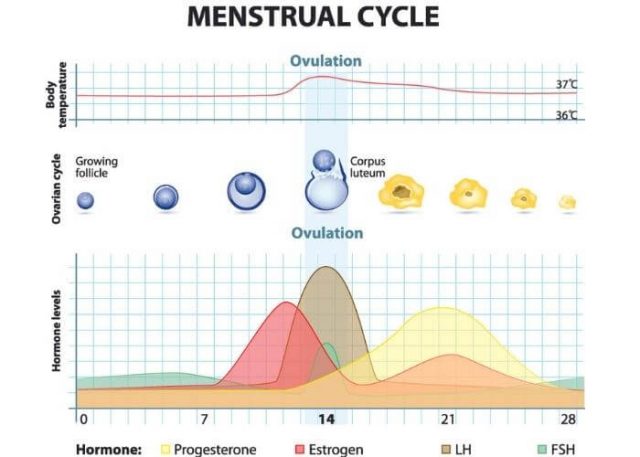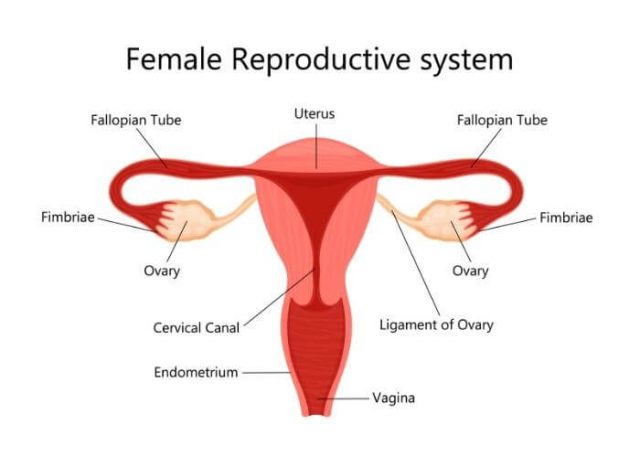The menstrual cycle occurs once every month in a woman’s body. It involves the ovaries, brain, pituitary gland (located in the brain), and uterus, which prepare the body for pregnancy. The pituitary gland produces two hormones: Follicle-Stimulating Hormone (FSH) and Luteinizing Hormone (LH). Progesterone and estrogen are two hormones produced by the ovaries.
Every month, a buildup of the uterus lining prepares the body for pregnancy. If there is no fertilization of the released egg by sperm, the buildup is shed, causing blood and tissue to pass out of the body through the vagina. This is called a “period” or “menses”. The duration of a normal menstrual period is equal to or less than 8 days. A girl generally starts her period between 8 and 15 years of age.
The menstrual cycle generally lasts 28-35 days. The first day of the period represents the first day of the menstrual cycle. The menstrual cycle then ends on the first day of the next period. The menstrual cycle’s length may vary month-to-month, but periods are considered regular if they usually come every 24-38 days. There may be significantly more cycle variability during the first 5-7 years after the periods begin, and the last 10 years before the periods cease.
The 3 menstrual cycle phases are the follicular phase, midcycle surge and ovulation, and luteal phase.


Follicular phase
The follicular phase normally lasts 14-21 days, depending on the duration of the menstrual cycle. The follicular phase is 14 days for a person with a menstrual cycle duration of 28 days and 21 days with a menstrual cycle duration of 35 days. The follicular phase ends with a surge of luteinizing hormone (a high amount of LH hormone).
During this phase, one dominant follicle is destined to ovulate (egg is released) in the ovary due to increases in FSH. The follicle causes the level of estrogen to rise. This increase in estrogen causes the lining of the uterus to become thick and stimulates the pituitary to release a large amount of LH.
Mid-cycle surge and ovulation
The LH surge during the mid-cycle results in ovulation (release of the oocyte from the follicle). Ovulation occurs approximately 36 hours after the LH surge.
A woman is most likely to get pregnant if she has sex without birth control in the three days before and up to the day of ovulation. A woman’s egg lives only 12-24 hours after ovulation. In contrast, sperm can live 3-5 days inside a woman’s reproductive organs.
Luteal phase
The luteal phase normally lasts 14 days for women regardless of the duration of the normal menstrual cycle. The luteal phase remains relatively constant, and changes in the interval between the periods are primarily due to changes in the follicular phase.
After ovulation, the ovary also produces progesterone. During the mid to late luteal phase, progesterone gradually rises and there is a progressive slowing of LH secretion. Progesterone is the hormone that prepares the body for pregnancy.
If the released egg is fertilized by the sperm, it develops into an embryo (unborn offspring in the process of development). The embryo travels through the fallopian tube to the uterus. Progesterone prepares the uterus for the embryo to be implanted. The early embryo begins to secrete the chorionic gonadotrophin hormone, which maintains progesterone production.
If the egg is not fertilized by the sperm, the lining of the uterus is shed, causing a menstrual period, and the progesterone and estrogen gradually fall.


Changing hormone levels throughout the menstrual cycle are responsible for the various symptoms that may occur. These include mood swings, depression, anxiety, and changes in energy level.
Menstrual blood is the only source of blood that is not traumatically induced. Yet in modern society, this is the most hidden blood, the one so rarely spoken of and almost never seen, except privately by women.
– Judy Grahn


